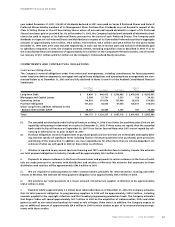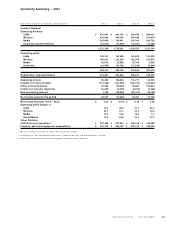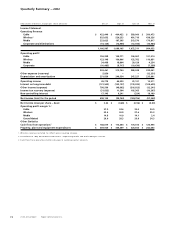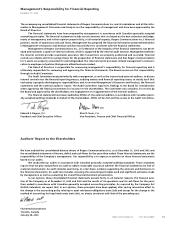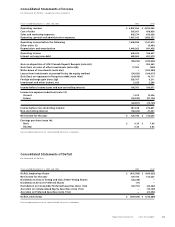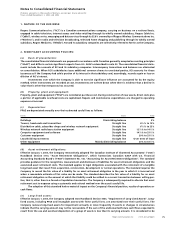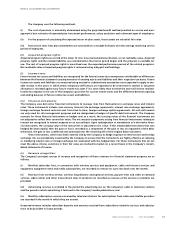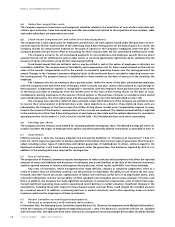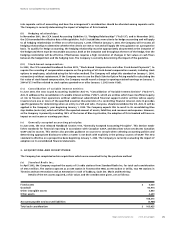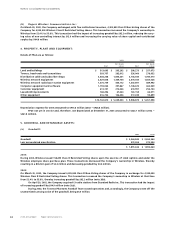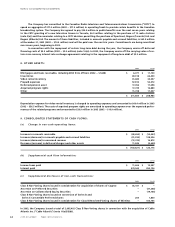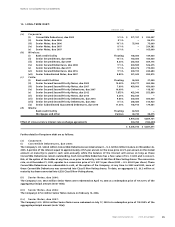Rogers 2003 Annual Report Download - page 79
Download and view the complete annual report
Please find page 79 of the 2003 Rogers annual report below. You can navigate through the pages in the report by either clicking on the pages listed below, or by using the keyword search tool below to find specific information within the annual report.
2003 Annual ReportRogers Communications Inc. 77
Notes to Consolidated Financial Statements
The Company uses the following methods:
(i) The cost of pensions is actuarially determined using the projected benefit method prorated on service and man-
agement’s best estimate of expected plan investment performance, salary escalation and retirement ages of employees.
(ii) For the purpose of calculating the expected return on plan assets, those assets are valued at fair value.
(iii) Past service costs from plan amendments are amortized on a straight-line basis over the average remaining service
period of employees.
(k) Acquired program rights:
Acquired program rights are carried at the lower of cost, less accumulated amortization, or net realizable value. Acquired
program rights and the related liabilities are recorded when the licence period begins and the program is available for
use. The cost of acquired program rights is amortized over the expected performance period of the related programs.
Net realizable value of acquired program rights is reviewed using a daypart methodology.
(l) Income taxes:
Future income tax assets and liabilities are recognized for the future income tax consequences attributable to differences
between the financial statement carrying amounts of existing assets and liabilities and their respective tax bases. Future
income tax assets and liabilities are measured using enacted or substantively enacted tax rates expected to apply to tax-
able income in the years in which those temporary differences are expected to be recovered or settled. A valuation
allowance is recorded against any future income tax asset if it is more likely than not that the asset will not be realized.
Income tax expense is the sum of the Company’s provision for current income taxes and the difference between opening
and ending balances of future income tax assets and liabilities.
(m) Financial instruments:
The Company uses derivative financial instruments to manage risks from fluctuations in exchange rates and interest
rates. These instruments include cross-currency interest rate exchange agreements, interest rate exchange agreements,
foreign exchange forward contracts and, from time to time, foreign exchange option agreements. All such instruments
are only used for risk management purposes and are designated as hedges of specific debt instruments. The Company
accounts for these financial instruments as hedges and, as a result, the carrying values of the financial instruments are
not adjusted to reflect their current fair value. The net receipts or payments arising from financial instruments relating to
interest are recognized in interest expense on an accrual basis. Upon redesignation or amendment of a derivative finan-
cial instrument, the carrying value of the instrument is adjusted to fair value. If the related debt instrument that was
hedged has been repaid, then the gain or loss is recorded as a component of the gain or loss on repayment of the debt.
Otherwise, the gain or loss is deferred and amortized over the remaining life of the original debt instrument.
These instruments, which have been entered into by the Company to hedge exposure to interest rate and foreign
exchange risk, are periodically examined by the Company to ensure that the instruments are highly effective at reducing
or modifying interest rate or foreign exchange risk associated with the hedged item. For those instruments that do not
meet the above criteria, variations in their fair value are marked-to-market on a current basis in the Company’s consoli-
dated statements of income.
(n) Revenue recognition:
The Company’s principal sources of revenue and recognition of these revenues for financial statement purposes are as
follows:
(i) Monthly subscriber fees, in connection with wireless services and equipment, cable and Internet services and
equipment, equipment rental and media subscriptions, are recorded as revenue on a pro rata basis over the month;
(ii) Revenue from wireless airtime, wireless long-distance and optional services, pay-per-view and video on demand
services, video rentals and other transactional sales of products are recorded as revenue as the services or products are
provided;
(iii) Advertising revenue is recorded in the period the advertising airs on the Company’s radio or television stations
and the period in which advertising is featured in the Company’s media publications; and
(iv) Monthly subscription revenues received by television stations for subscriptions from cable and satellite providers
are recorded in the month in which they are earned.
Unearned revenue includes subscriber deposits and amounts received from subscribers related to services and subscrip-
tions to be provided in future periods.


